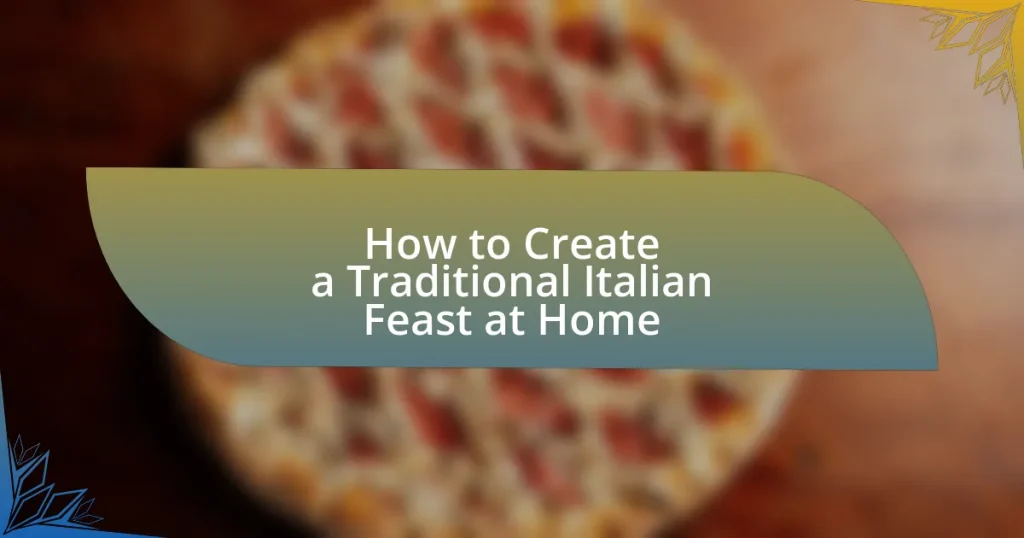A Traditional Italian Feast is a communal dining experience that celebrates Italian culture through a multi-course meal featuring regional dishes. This article outlines the essential components of such a feast, including antipasti, pasta, main courses, and desserts, while emphasizing the importance of family and community in Italian culinary traditions. It also explores the historical origins, regional variations, and key elements that define these feasts, providing practical tips for recreating an authentic Italian dining experience at home. Additionally, the article discusses the significance of wine pairings, the role of coffee, and best practices for hosting a successful feast.

What is a Traditional Italian Feast?
A Traditional Italian Feast is a communal meal that celebrates Italian culture, featuring a variety of dishes served in multiple courses. These feasts often include antipasti, pasta, meat, and dessert, reflecting regional specialties and seasonal ingredients. Historically, such feasts are rooted in family gatherings and religious celebrations, emphasizing the importance of sharing food and fostering community bonds. The practice of enjoying a lengthy meal with family and friends is a hallmark of Italian culinary tradition, highlighting the significance of food in social and cultural contexts.
How is a Traditional Italian Feast different from other types of feasts?
A Traditional Italian Feast is distinct from other types of feasts primarily due to its emphasis on communal dining, regional culinary traditions, and a multi-course meal structure. Unlike many feasts that may focus on a single dish or a buffet-style service, a Traditional Italian Feast typically features a series of courses that highlight local ingredients and recipes, reflecting Italy’s diverse regional cuisines. For instance, a feast may include antipasti, pasta, main courses, and desserts, each representing different Italian regions, such as risotto from Lombardy or seafood from Sicily. This structured approach to dining fosters a sense of community and celebration, making the experience more about togetherness and cultural heritage than merely the food itself.
What are the key elements that define a Traditional Italian Feast?
A Traditional Italian Feast is defined by several key elements: a variety of authentic dishes, communal dining, and a focus on fresh, high-quality ingredients. The feast typically includes multiple courses, such as antipasti, pasta, main dishes, and desserts, showcasing regional specialties. Communal dining emphasizes sharing and togetherness, often featuring large tables filled with food for family and friends. Fresh ingredients, often sourced locally, are essential to maintain the traditional flavors and authenticity of the dishes. These elements reflect Italy’s rich culinary heritage and the importance of food in social gatherings.
Why is the concept of family important in a Traditional Italian Feast?
The concept of family is important in a Traditional Italian Feast because it embodies the values of togetherness, love, and shared heritage. In Italian culture, meals are not just about food; they are a time for family members to gather, strengthen bonds, and celebrate traditions. This communal aspect is reflected in the preparation and enjoyment of the feast, where recipes are often passed down through generations, emphasizing the significance of familial ties. Historical practices show that Italian feasts often involve large gatherings, reinforcing the idea that food serves as a medium for connection and cultural identity.
What are the cultural origins of a Traditional Italian Feast?
The cultural origins of a Traditional Italian Feast stem from Italy’s agrarian roots and communal celebrations. Historically, these feasts were tied to the harvest cycle, religious festivals, and family gatherings, reflecting the importance of food in Italian culture. For instance, the Feast of San Gennaro in Naples celebrates the patron saint with food, music, and community, showcasing how religious and cultural practices intertwine. Additionally, regional variations in ingredients and dishes highlight Italy’s diverse culinary heritage, with each area contributing unique flavors and traditions to the feast.
How do regional variations influence the feast’s structure?
Regional variations significantly influence the structure of a feast by determining the types of dishes served, the order of courses, and the ingredients used. For instance, in Northern Italy, feasts often feature polenta and risotto, while Southern Italian feasts emphasize pasta and seafood, reflecting local agricultural practices and available resources. Additionally, the inclusion of specific regional wines and cheeses further tailors the feast to local traditions, enhancing the overall dining experience. This diversity in culinary practices showcases the rich cultural heritage of Italy, where each region’s unique flavors and customs shape the feast’s composition.
What historical events shaped the traditions of Italian feasting?
The traditions of Italian feasting have been shaped by several historical events, including the Roman Empire’s expansion, the influence of the Catholic Church, and the agricultural practices of the Renaissance. The Roman Empire established a culture of communal dining and elaborate banquets, which emphasized the importance of food in social and political life. The Catholic Church’s liturgical calendar introduced specific feast days that dictated communal meals, such as Christmas and Easter, fostering a tradition of family gatherings centered around food. Additionally, the Renaissance period saw advancements in agriculture and trade, leading to a greater variety of ingredients and culinary techniques, which enriched Italian cuisine and feasting practices. These events collectively contributed to the rich tapestry of Italian feasting traditions observed today.

What are the essential components of a Traditional Italian Feast?
The essential components of a Traditional Italian Feast include a variety of antipasti, pasta dishes, main courses featuring meat or fish, side dishes, desserts, and a selection of wines. Antipasti typically consist of cured meats, cheeses, olives, and marinated vegetables, setting the stage for the meal. Pasta dishes, such as lasagna or spaghetti, serve as a staple, often accompanied by rich sauces. Main courses may feature roasted meats or seafood, reflecting regional specialties. Side dishes often include seasonal vegetables or salads, enhancing the meal’s balance. Desserts like tiramisu or panna cotta provide a sweet conclusion, while wines, particularly regional varieties, complement the flavors throughout the feast. This structure reflects traditional Italian culinary practices, emphasizing communal dining and the celebration of local ingredients.
What types of dishes are typically served at a Traditional Italian Feast?
A Traditional Italian Feast typically includes a variety of dishes such as antipasti, pasta, meat, and desserts. Antipasti often features cured meats, cheeses, olives, and marinated vegetables. Pasta dishes may include lasagna, ravioli, or spaghetti with various sauces. For the main course, roasted meats like porchetta or osso buco are common, often accompanied by seasonal vegetables. Desserts such as tiramisu or cannoli conclude the meal. These dishes reflect regional Italian cuisine and are often prepared for family gatherings and celebrations, emphasizing communal dining and rich flavors.
How do appetizers set the tone for the feast?
Appetizers set the tone for the feast by stimulating the palate and creating anticipation for the meal. They serve as an introduction to the flavors and culinary style of the feast, often reflecting the cultural significance and traditional elements of the cuisine. For instance, in a traditional Italian feast, appetizers like bruschetta or antipasto platters showcase regional ingredients and flavors, establishing a festive atmosphere. This initial course not only engages guests but also encourages social interaction, enhancing the overall dining experience.
What are the most popular main courses in a Traditional Italian Feast?
The most popular main courses in a Traditional Italian Feast include Lasagna, Osso Buco, and Porchetta. Lasagna, a layered pasta dish with meat, cheese, and tomato sauce, is a staple in Italian cuisine, often served during festive occasions. Osso Buco, which consists of braised veal shanks, is traditionally accompanied by gremolata and risotto, showcasing the rich flavors of Italian cooking. Porchetta, a savory, herb-stuffed roast pork, is celebrated for its crispy skin and tender meat, making it a favorite centerpiece for feasts. These dishes reflect the regional diversity and culinary heritage of Italy, often prepared for family gatherings and special celebrations.
What beverages complement a Traditional Italian Feast?
Red wine, particularly Chianti, complements a Traditional Italian Feast effectively due to its acidity and tannins that balance rich flavors. Additionally, Prosecco serves as a refreshing sparkling option, enhancing the meal’s celebratory nature. Historical context shows that these beverages have been staples in Italian dining, with Chianti originating from Tuscany and Prosecco from the Veneto region, both regions known for their culinary traditions. This pairing not only aligns with authentic Italian customs but also elevates the overall dining experience.
How do wine pairings enhance the dining experience?
Wine pairings enhance the dining experience by complementing and elevating the flavors of the food. When wine is matched with specific dishes, it can enhance the taste profiles, creating a harmonious balance that makes each bite more enjoyable. For example, a full-bodied red wine can bring out the richness of a meat dish, while a crisp white wine can highlight the freshness of seafood. Studies have shown that the right wine can improve the perception of flavors, making the overall meal more satisfying. This synergy between food and wine not only enhances taste but also contributes to the overall ambiance and enjoyment of the dining experience.
What role does coffee play in the conclusion of the feast?
Coffee serves as a traditional digestif at the conclusion of the feast, enhancing the overall dining experience. In Italian culture, serving coffee after a meal is customary, as it aids digestion and provides a pleasant end to the meal. This practice is rooted in the belief that coffee stimulates the digestive system, making it a fitting conclusion to a multi-course feast.

How can you recreate a Traditional Italian Feast at home?
To recreate a Traditional Italian Feast at home, start by preparing a multi-course meal that includes antipasti, pasta, a main dish, and dessert. Antipasti can feature cured meats, cheeses, olives, and marinated vegetables, reflecting the Italian tradition of sharing small bites. For the pasta course, homemade pasta such as tagliatelle or ravioli served with a rich sauce like Bolognese or marinara is essential, as pasta is a staple in Italian cuisine. The main dish could be a classic like osso buco or a roasted meat, accompanied by seasonal vegetables. Finally, finish the feast with a traditional dessert such as tiramisu or panna cotta, which highlights the importance of sweets in Italian celebrations. This structure mirrors the authentic Italian dining experience, which emphasizes communal eating and a variety of flavors.
What steps should you follow to plan your feast?
To plan your feast, start by selecting a theme and menu that reflects traditional Italian cuisine. This involves choosing a variety of dishes such as antipasti, pasta, main courses, and desserts that are authentic to Italian culture. Next, create a guest list to determine the number of servings needed, ensuring that you account for dietary restrictions. Following this, gather all necessary ingredients, prioritizing fresh and high-quality items, as Italian cooking emphasizes the use of seasonal produce. After that, establish a timeline for preparation and cooking, allowing ample time for each dish to be made and served at the right temperature. Finally, set the dining area to create an inviting atmosphere, incorporating traditional Italian decor elements like tablecloths and candles. These steps ensure a well-organized and enjoyable feast experience.
How do you select the right recipes for your feast?
To select the right recipes for your feast, first consider the traditional Italian dishes that align with the theme of your event. Focus on classic recipes such as pasta, risotto, and antipasti that are commonly served during Italian feasts. Research indicates that incorporating regional specialties enhances authenticity; for example, using recipes from regions like Emilia-Romagna for pasta dishes or Campania for pizza can provide a genuine experience. Additionally, consider dietary preferences and seasonal ingredients to ensure the menu is appealing and fresh. This approach not only respects culinary traditions but also caters to your guests’ tastes, making the feast memorable.
What ingredients are essential for an authentic experience?
Essential ingredients for an authentic Italian experience include high-quality olive oil, fresh tomatoes, garlic, basil, and Parmigiano-Reggiano cheese. These ingredients are foundational in traditional Italian cuisine, contributing to the rich flavors and authenticity of dishes. For instance, extra virgin olive oil is often used as a base for sauces and dressings, while fresh tomatoes are crucial for making classic sauces like marinara. Garlic and basil enhance the aromatic profile of many Italian recipes, and Parmigiano-Reggiano is a staple cheese that adds depth to pasta and risotto dishes. The use of these specific ingredients reflects the culinary traditions of Italy, ensuring a genuine dining experience.
What tips can help ensure your feast is successful?
To ensure your feast is successful, plan your menu carefully, focusing on traditional Italian dishes that complement each other. Selecting recipes that balance flavors and textures, such as pairing a rich pasta dish with a light salad, enhances the dining experience. Additionally, preparing dishes in advance allows for a smoother cooking process on the day of the feast, reducing stress and ensuring timely service. Setting the table with attention to detail, including proper utensils and decorations, creates an inviting atmosphere that enhances the overall experience. Finally, consider the pacing of the meal; serving courses at appropriate intervals keeps guests engaged and satisfied throughout the feast.
How can you create an inviting atmosphere for your guests?
To create an inviting atmosphere for your guests, focus on warm lighting, comfortable seating, and engaging decor. Warm lighting, such as soft lamps or candles, enhances the ambiance and makes the space feel cozy. Comfortable seating arrangements encourage conversation and relaxation, while engaging decor, like Italian-themed table settings or fresh flowers, adds a personal touch that reflects the theme of a traditional Italian feast. Studies show that environments with these elements promote social interaction and enjoyment, making guests feel more welcome and at ease.
What common mistakes should you avoid when hosting a feast?
When hosting a feast, common mistakes to avoid include inadequate planning, which can lead to food shortages or timing issues. Failing to create a balanced menu that accommodates dietary restrictions may alienate guests, while neglecting to set a comfortable atmosphere can diminish the overall experience. Additionally, overcomplicating recipes can result in stress and subpar dishes, while not delegating tasks can overwhelm the host. Lastly, forgetting to consider portion sizes may lead to waste or insufficient food for guests.
What are some best practices for serving a Traditional Italian Feast?
To serve a Traditional Italian Feast effectively, begin by organizing the meal into multiple courses, typically starting with antipasti, followed by pasta, a main dish, and concluding with dessert. This structure reflects the traditional Italian dining experience, which emphasizes savoring each course.
Ensure that each dish is prepared with high-quality, fresh ingredients, as Italian cuisine prioritizes the use of seasonal produce and authentic flavors. For example, using San Marzano tomatoes for sauces enhances the overall taste and authenticity of the meal.
Serve the courses in a leisurely manner, allowing guests to enjoy each dish fully before moving on to the next. This practice aligns with the Italian cultural value of communal dining, where meals are a time for connection and conversation.
Accompany the feast with appropriate Italian wines, such as Chianti for red sauces or Pinot Grigio for lighter dishes, to complement the flavors of the food. This pairing enhances the dining experience and showcases the regional diversity of Italian wines.
Finally, create a warm and inviting atmosphere with rustic table settings, including simple yet elegant tableware and fresh flowers, to reflect the Italian tradition of hospitality. This attention to detail contributes to an authentic and memorable dining experience.
How should you time the serving of different courses?
To time the serving of different courses in a traditional Italian feast, serve each course approximately 15 to 20 minutes apart. This interval allows guests to enjoy each dish fully while maintaining a relaxed dining atmosphere. For example, start with antipasti, followed by the primo (first course) like pasta, then the secondo (second course) such as meat or fish, and finally, conclude with dolce (dessert). This pacing aligns with traditional Italian dining customs, which emphasize savoring food and conversation, ensuring that each course is appreciated without feeling rushed.
What are effective ways to engage guests during the feast?
Effective ways to engage guests during the feast include interactive food stations, games, and storytelling. Interactive food stations allow guests to customize their dishes, fostering participation and conversation. For example, a pasta bar where guests can choose their sauces and toppings encourages interaction. Games such as trivia related to Italian culture or cooking can stimulate engagement and laughter. Additionally, storytelling about the origins of the dishes or family traditions can create a warm atmosphere, making guests feel more connected to the experience. These methods not only enhance enjoyment but also promote social interaction, making the feast memorable.















